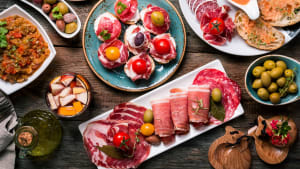Discovering Spanish Food Culture on the Costas
Spain is famous for its warm climate, stunning coastlines, and rich culture, but one of the true joys of life here is undoubtedly the food. The eating habits and culinary traditions of Spain, particularly in regions like the Costa del Sol and Costa Blanca, are an integral part of daily life. Offering a delicious blend of history, social connection, and fresh Mediterranean flavours, Spanish cuisine is sure to delight.
If you’re considering making the move to these beautiful coastal regions, or simply want to immerse yourself in Spanish cuisine during your next visit, here’s what you need to know about the eating habits, customs, and traditions that define food culture on the Costas. ¡Buen provecho!
The Art of Leisurely Eating
One of the first things you’ll notice about eating in Spain is the relaxed approach to mealtimes. Unlike the hurried, practical dining culture found in many northern European countries, the Spanish prefer to take their time, enjoying long, sociable meals that can stretch into the afternoon or late into the night.
- Lunch (la comida) is traditionally the most important meal of the day, often consisting of multiple courses and lasting anywhere from one to two hours. It’s typically eaten between 2pm and 4pm, and many local businesses still close during this period to allow people to enjoy their meal without rush.
- Dinner (la cena), on the other hand, is much later than many expats are used to, often starting from 9pm onwards. Given the warm evenings on the Costa del Sol and Costa Blanca, this late dining habit is a delightful way to enjoy outdoor terraces and lively Spanish streets after the heat of the day has passed.
Tapas Culture: A Way of Life
Spain’s famous tapas culture is deeply ingrained in both Costa Blanca and Costa del Sol. Tapas are small dishes meant to be shared, creating a social and interactive dining experience.
- In some parts of Spain, ordering a drink means you’ll receive a complimentary tapa, but in the Costas, tapas are often ordered individually or as a full meal.
- Popular tapas include gambas al ajillo (garlic prawns), albondigas (Spanish meatballs), and pimientos de padrón (fried green peppers sprinkled with sea salt).
- Pair these with a glass of local wine or a crisp cerveza, and you’ve got the perfect way to spend an evening with friends.
Fresh and Local Mediterranean Diet
Both the Costa Blanca and Costa del Sol benefit from their coastal locations, which means fresh seafood plays a starring role in the local cuisine.
- Paella, originally from the Valencia region, is a staple on the Costa Blanca, with seafood variations featuring prawns, mussels, and squid.
- On the Costa del Sol, espetos (sardines skewered on sticks and grilled over an open fire) are a must-try, best enjoyed at a beachfront chiringuito (beach bar) with the sea breeze in your hair.
Spain’s Mediterranean diet is renowned for its health benefits, incorporating plenty of fresh vegetables, olive oil, nuts, and lean meats. Whether it’s a simple ensalada mixta (mixed salad), gazpacho (cold tomato soup), or a hearty dish of pulpo a la gallega (Galician-style octopus), the emphasis is always on high-quality, locally sourced ingredients.
Market Shopping and Home Cooking
While Spain is home to fantastic restaurants and bars, many locals still prefer to shop at traditional markets for their ingredients.
- In towns and cities across the Costa Blanca and Costa del Sol, you’ll find bustling mercados filled with fresh fish, artisanal cheeses, cured meats, and an abundance of colourful fruits and vegetables.
- Shopping at these markets not only provides access to the freshest produce but also allows you to engage with local vendors, many of whom have been selling their goods for generations. It’s a great way to experience authentic Spanish culture while also supporting small businesses.
Sweet Treats and Coffee Culture
No Spanish dining experience is complete without something sweet to finish.
- On the Costa Blanca, turrón (a traditional almond nougat) is a regional speciality, particularly popular during the festive season.
- Meanwhile, on the Costa del Sol, churros con chocolate, deep-fried dough sticks dipped into thick, rich hot chocolate, are a favourite indulgence, best enjoyed as a mid-morning snack or late-night treat.
Coffee culture is also deeply embedded in Spanish life. Locals take their coffee seriously, whether it’s a morning café con leche (coffee with milk), a post-lunch cortado (espresso with a splash of milk), or a strong café solo (black espresso) to round off a meal. Coffee breaks are not just about caffeine; they are moments of pause and social connection.
The Role of Wine and Spirits
Spain is one of the world’s top wine-producing countries, and both Costa Blanca and Costa del Sol boast excellent local wines.
- The Valencia and Alicante regions produce fantastic white and red wines, while Málaga is known for its sweet, fortified wines made from Moscatel grapes.
- Pairing a local wine with your meal is almost second nature here, whether it’s a crisp white to accompany seafood or a robust red with a meat dish.
Spain is also known for its traditional spirits, such as pacharán (a sloe-infused liqueur from the north of Spain) and the ever-popular gin and tonic, which is served in large balloon glasses and enjoyed in the warm evening air.
This guide to food culture on the Costas will help you savor every moment of your Spanish experience. Whether you’re indulging in tapas, shopping for fresh produce at a market, or enjoying a glass of local wine, you’re sure to find that food is an integral part of life here.





